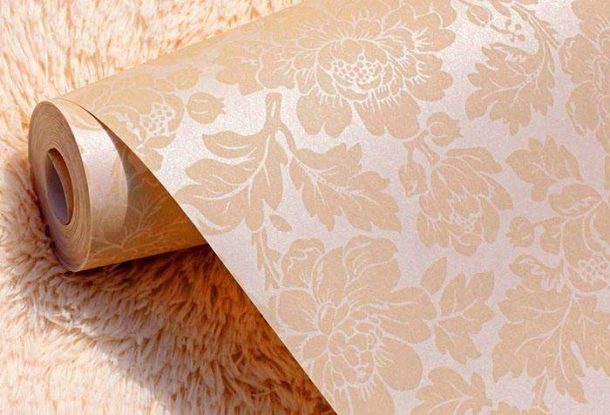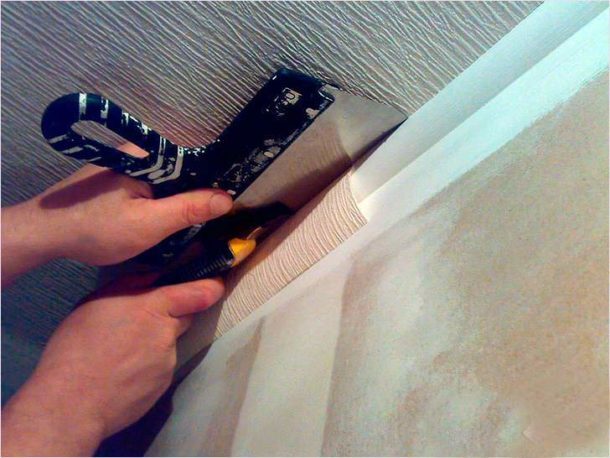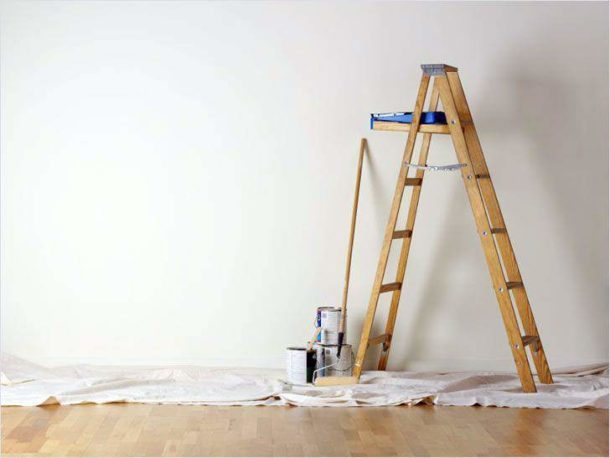Content
- Choose a wallpaper
- The nuances of working with paper wallpaper
- Vinyl on a different substrate: which is easier to glue?
- Flizelin - an ideal choice for a ceiling?
- We select wallpaper glue
- We prepare the base
- Ceiling marking
- Cut the wallpaper
- Glue paper wallpaper or vinyl paper-based
- Gluing non-woven wallpaper or vinyl on a non-woven basis alone
As an alternative to banal dyeing and whitewashing, many prefer to wallpaper the ceiling. They will hide small flaws of the base surface - cracks, small irregularities - allowing you to spend less money and effort on preparing the ceiling. A variety of textures, colors and designs at a moderate cost allows you to expand your wings of fantasy. In addition, you can glue wallpaper on the ceiling yourself, without involving professionals for this.

Choose a wallpaper
The selected type of wallpaper affects the technology of pasting and some other features of the process. Experts recommend stopping at one of the following varieties:
- paper;
- paper based vinyl;
- non-woven vinyl;
- non-woven.
The choice will be affected by the condition of the base ceiling, requirements for material and drawing, financial capabilities. By the way, the paper version will cost you the smallest amount, and vinyl and non-woven wallpapers will cost more, but they will also last longer.

Important! For the ceiling, material with a minimum weight is selected. It should not exceed 110 g / sq. m. This parameter is usually indicated on the roll label.
The nuances of working with paper wallpaper
The surface and colors of this type of canvas can vary, in the simplest the lower layer has a rough texture, and the upper one is smooth. It is on it that a drawing is applied. Due to the small thickness of the paper sheets it is quite difficult to stick correctly, in addition, they will repeat all the existing defects of the ceiling. If it is uneven, it is better to give preference to another variety of finishing material.

True, construction stores offer thicker options for paper wallpaper - embossed. Such canvases are already less demanding on the surface.
Vinyl on a different substrate: which is easier to glue?
Vinyl wallpapers differ in type of basis (paper or non-woven). That it affects the technique of gluing and the choice of wallpaper glue:
- the material on the paper substrate is impregnated with glue, and then applied to the surface, so gluing them to the ceiling is not very convenient, although it is still easier than ordinary paper wallpaper;
- fizelin-based sheets do not need to be lubricated with glue, the composition is applied only to the ceiling, so working with them is easier.
USEFUL INFORMATION:How to glue ceiling skirting boards on the wallpaper and can it be done?
Compared to paper, such wallpapers are more wear-resistant, last longer, and due to their high density and relief they better hide the imperfections in the ceiling in the apartment.

Flizelin - an ideal choice for a ceiling?
Wallpaper made of non-woven fabric - a nonwoven fabric made from cellulose fibers - is a popular solution for the ceiling, giving it an original appearance and soft glow. In this case, it is permissible to perform up to 12 repaints.
Non-woven wallpaper are different:
- high strength - it is very difficult to break them by accident;
- lack of shrinkage - do not stretch from getting wet, do not shrink after drying;
- compatibility with any surfaces;
- the ability to align the ceiling with minor defects.

Tip. If you want to paste the ceiling with minimal effort, choose wide wallpaper from a non-woven fabric or based on it. Unlike paintings on a paper substrate, they do not need to be smeared with glue, the composition is applied only to the surface to be glued. This greatly facilitates work in uncomfortable conditions. The large width of the strips will speed up the process and reduce the number of seams.
We select wallpaper glue
Choosing the adhesive composition, be sure to consider the selected variety of wallpaper. For the ceiling, this axiom is especially relevant, because under its own weight, heavy canvases glued to improper glue can simply fall off.
Wallpaper glue is chosen according to the following principle:
- For paper wallpapers, a starch-based adhesive is suitable, in which special components are added that impede the development of the fungus.
- When using vinyl and non-woven wallpaper, you should choose starch glue with the addition of methyl cellulose, which is characterized by high adhesion with the base and plasticity.
- If heavy vinyl finishing materials are selected, the adhesive for them, in addition to starch and methyl cellulose, must contain polymer additives and a biocide.
There are universal options for adhesives that are suitable for any type of wallpaper. Their parameters are adjusted depending on the amount of added water.
When buying, carefully select the adhesive composition, read the instructions.

We prepare the base
The ceiling can be concrete, plasterboard, you can also stick wallpaper on chipboard and plywood. Before starting the final finish, the foundation should be prepared. To do this, clean it, align it, repair cracks and other shortcomings. All previous coverage should be completely removed. After completion of these works, the base is primed.
USEFUL INFORMATION:Soundproofing rooms in an apartment in a new building
Wallpaper with proper preparation can be glued even on complex surfaces:
- on the ceiling, insulated with foam or foam;
- old PVC panels that do not want to be removed due to defects on the draft ceiling that will have to be fixed;
- a surface painted with oil paint, which is very difficult to remove and from which the wallpaper may lag.
In the three above cases, fiberglass is attached to the ceiling. How and how to glue it on different coatings, read here. After installing fiberglass, the surface is primed and putty.

The steps for preparing a concrete base are described in detail. here.
For processing drywall before wallpapering, read this article.

Ceiling marking
First of all, you need to decide whether the wallpaper will be glued along or across the long wall. You can choose the direction of the bands according to several principles:
- Focusing on the location of the windows. Wallpaper should go perpendicular to them, in the direction of the incident light, then the joints will not be so noticeable.
- Minimizing the number of stitches. In this case, the strips are located along a long wall. Please note that the gluing process will be complicated: with long canvases it is more difficult to manage both in terms of raising to the ceiling and in terms of combining joints.
- Focusing on the maximum ease of gluing. Working with short strips is much easier than working with long ones, especially when finishing the ceiling alone. From this point of view, it makes sense to glue the canvas along a short wall, across the width of the room.

First we outline the guide line for the first strip. The easiest way to do this is with the laser level or pull a cord from one of the walls, along which to set the labels.
Important! If the ceiling skirting has not yet been installed, you need to make markings so that the extreme canvases come on the wall with an overlap of 2-3 cm.
Cut the wallpaper
You can facilitate your work if you first cut the required number of strips. Consider it, given the parameters of the room, the width and length of the roll.
If fitting the drawing is required, this should also be taken care of at the cutting stage.
Glue paper wallpaper or vinyl paper-based
These two types of material are glued according to the same principle, with one difference: paper sheets, especially thin ones, require much more gentle handling. After impregnation with glue, they can break and crumple.
USEFUL INFORMATION:Can I make a suspended ceiling in the bathroom?
Work order:
- Apply the adhesive solution directly onto the canvas with an even layer.
- We add up a section of wallpaper, but not like for walls, in half or with an “envelope”, but with an “accordion”, leave it for 5-10 minutes. It is important to ensure that the glue does not get on the front side.
- We apply glue to the base, using a mid-ply roller for this.
- We apply a strip of material to the marking line in any convenient corner with a slight overlap on the wall, smooth it by hand from the center to the edges, gradually fixing the entire canvas.
- We expel excess glue and air bubbles with a brush or a plastic spatula, performing movements from the center to the edge at an angle of 45 °.

One person is unlikely to be able to qualitatively perform these actions, it is better to find an assistant.
Tip. You can cope with sticking paper wallpapers alone with drywall hoist, which will support the canvas, and several tables or construction goats, arranged in a row to move along them.
Gluing non-woven wallpaper or vinyl on a non-woven basis alone
We also combined these types of wallpapers in one group: they have a common gluing technology. Its use will help to finish the ceiling yourself, without helpers.
- We apply glue directly to the base with an even thick layer, using a long-nap roller for this purpose. It is not necessary to immediately cover the entire ceiling with the composition, it is enough to lubricate the surface with a small margin of strip width.
- The edge of the cut-off canvas, previously rolled into a tube, is applied to the mark.
- With one hand we hold the received thin roll, with the other we smooth the canvas.
- We expel air from under the sheets with a plastic spatula.
- We begin gluing the next strip immediately after the first, because the adhesive quickly dries. Cloths are glued butt.

The last stage is the same for all types of wallpaper:
- Excess material at the ceiling of the skirting board is cut with a sharp knife that rests on a wide metal spatula used as a ruler, as in the following photo.
- If the fillet is not yet installed, an overlap of several centimeters is left, which, after drying, is cut off in the same way.

Important! Until the finishing material has completely dried, drafts should not be allowed in the room.
Wallpapering the ceiling is a laborious, but not very complicated process that can be done with your own hands. The main thing is to choose the right material, adhesive composition and find an assistant who can provide all possible assistance. For more knowledge, we recommend that you check out the videos below.


